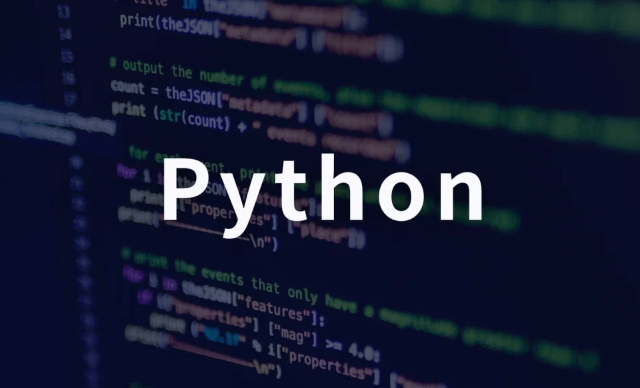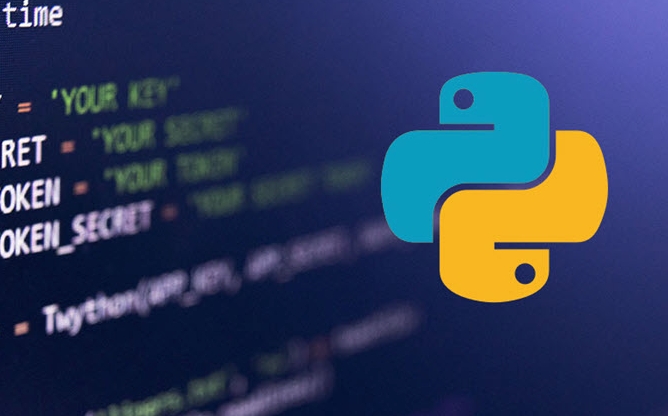 Backend Development
Backend Development
 Python Tutorial
Python Tutorial
 How to use property decorators to create managed attributes in a Python class?
How to use property decorators to create managed attributes in a Python class?
How to use property decorators to create managed attributes in a Python class?
Aug 01, 2025 am 06:41 AMUse the @property decorator to create controlled attributes. 1. Use @property to define read-only attributes and call the getter method when accessing; 2. Use the @property name.setter to add verification logic when assignment; 3. Use the @property name.deleter to define the behavior when deleting attributes; 4. Create dynamically calculated attributes such as area, diameter, etc.; 5. Advantages include encapsulation, data verification, interface compatibility and concise syntax, and ultimately implement intelligent management of attributes without exposing internal data.

Using property decorators in Python allows you to create managed attributes — class attributes that behave like regular attributes but have controlled access through getter, setter, and delete methods. This is useful for validating data, computing values on demand, or maintaining encapsulation without sacrificing a clean API.

Here's how to use the @property decorator effectively:
1. Basic Usage: Creating a Read-Only Property
You can use @property to turn a method into a "getter" for an attribute.

class Circle:
def __init__(self, radius):
self._radius = radius
@property
def radius(self):
return self._radius
# Usage
c = Circle(5)
print(c.radius) # 5
# c.radius = 10 # AttributeError: can't set attribute (by default) Here, radius is a managed attribute. Accessing c.radius calls the method, but you can't set it unless you define a setter.
2. Adding a Setter: Allow Controlled Assignment
Use @<property>.setter to define what happens when the attribute is assigned.

class Circle:
def __init__(self, radius):
self._radius = radius
@property
def radius(self):
return self._radius
@radius.setter
def radius(self, value):
if value < 0:
raise ValueError("Radius cannot be negative")
self._radius = value
# Usage
c = Circle(5)
c.radius = 10 # Works
# c.radius = -3 # Raises ValueError Now you can assign to radius , but invalid values are caught.
3. Adding a Deleter: Define Behavior on del
Use @<property>.deleter to specify what happens when del obj.attr is used.
@radius.deleter
def radius(self):
print("Deleting radius...")
del self._radius
# Usage
del c.radius # Prints message and removes _radiusThis is less commonly used but helpful for cleanup.
4. Computed Properties (Lazy or Derived Attributes)
You can use properties to compute values dynamically.
import math
class Circle:
def __init__(self, radius):
self._radius = radius
@property
def radius(self):
return self._radius
@radius.setter
def radius(self, value):
if value < 0:
raise ValueError("Radius cannot be negative")
self._radius = value
@property
def area(self):
return math.pi * self._radius ** 2
@property
def diameter(self):
return 2 * self._radius
# Usage
c = Circle(3)
print(c.area) # 28.274...
print(c.diameter) # 6 The area and diameter are not stored — they're computed when accessed, but feel like normal attributes.
5. Why Use Properties? Key Benefits
- Encapsulation : Hide internal representation (eg,
_radius) - Validation : Enforce rules in setters
- Backward Compatibility : Add logic later without changing the interface
- Clean Syntax : Users access via
obj.attr, notobj.get_attr()
Summary: Full Example
class Temperature:
def __init__(self, celsius=0):
self._celsius = celsius
@property
def celsius(self):
return self._celsius
@celsius.setter
def celsius(self, value):
if value < -273.15:
raise ValueError("Temperature below absolute zero is not possible")
self._celsius = value
@property
def fahrenheit(self):
return self._celsius * 9/5 32
@fahrenheit.setter
def fahrenheit(self, value):
self.celsius = (value - 32) * 5/9 # Reuse celsius validation
# Usage
t = Temperature(25)
print(t.fahrenheit) # 77.0
t.fahrenheit = 86
print(t.celsius) # 30.0This shows how properties make attributes smart while keeping usage simple.
Basically, just remember:
- Use
@propertyfor the getter - Use
@property_name.setterfor assignment - Use
@property_name.deleterif needed - Always validate or compute inside these methods
It's a clean way to manage attribute access without exposing raw data.
The above is the detailed content of How to use property decorators to create managed attributes in a Python class?. For more information, please follow other related articles on the PHP Chinese website!

Hot AI Tools

Undress AI Tool
Undress images for free

Undresser.AI Undress
AI-powered app for creating realistic nude photos

AI Clothes Remover
Online AI tool for removing clothes from photos.

Clothoff.io
AI clothes remover

Video Face Swap
Swap faces in any video effortlessly with our completely free AI face swap tool!

Hot Article

Hot Tools

Notepad++7.3.1
Easy-to-use and free code editor

SublimeText3 Chinese version
Chinese version, very easy to use

Zend Studio 13.0.1
Powerful PHP integrated development environment

Dreamweaver CS6
Visual web development tools

SublimeText3 Mac version
God-level code editing software (SublimeText3)

Hot Topics
 Polymorphism in python classes
Jul 05, 2025 am 02:58 AM
Polymorphism in python classes
Jul 05, 2025 am 02:58 AM
Polymorphism is a core concept in Python object-oriented programming, referring to "one interface, multiple implementations", allowing for unified processing of different types of objects. 1. Polymorphism is implemented through method rewriting. Subclasses can redefine parent class methods. For example, the spoke() method of Animal class has different implementations in Dog and Cat subclasses. 2. The practical uses of polymorphism include simplifying the code structure and enhancing scalability, such as calling the draw() method uniformly in the graphical drawing program, or handling the common behavior of different characters in game development. 3. Python implementation polymorphism needs to satisfy: the parent class defines a method, and the child class overrides the method, but does not require inheritance of the same parent class. As long as the object implements the same method, this is called the "duck type". 4. Things to note include the maintenance
 Python Function Arguments and Parameters
Jul 04, 2025 am 03:26 AM
Python Function Arguments and Parameters
Jul 04, 2025 am 03:26 AM
Parameters are placeholders when defining a function, while arguments are specific values ??passed in when calling. 1. Position parameters need to be passed in order, and incorrect order will lead to errors in the result; 2. Keyword parameters are specified by parameter names, which can change the order and improve readability; 3. Default parameter values ??are assigned when defined to avoid duplicate code, but variable objects should be avoided as default values; 4. args and *kwargs can handle uncertain number of parameters and are suitable for general interfaces or decorators, but should be used with caution to maintain readability.
 Explain Python generators and iterators.
Jul 05, 2025 am 02:55 AM
Explain Python generators and iterators.
Jul 05, 2025 am 02:55 AM
Iterators are objects that implement __iter__() and __next__() methods. The generator is a simplified version of iterators, which automatically implement these methods through the yield keyword. 1. The iterator returns an element every time he calls next() and throws a StopIteration exception when there are no more elements. 2. The generator uses function definition to generate data on demand, saving memory and supporting infinite sequences. 3. Use iterators when processing existing sets, use a generator when dynamically generating big data or lazy evaluation, such as loading line by line when reading large files. Note: Iterable objects such as lists are not iterators. They need to be recreated after the iterator reaches its end, and the generator can only traverse it once.
 Python `@classmethod` decorator explained
Jul 04, 2025 am 03:26 AM
Python `@classmethod` decorator explained
Jul 04, 2025 am 03:26 AM
A class method is a method defined in Python through the @classmethod decorator. Its first parameter is the class itself (cls), which is used to access or modify the class state. It can be called through a class or instance, which affects the entire class rather than a specific instance; for example, in the Person class, the show_count() method counts the number of objects created; when defining a class method, you need to use the @classmethod decorator and name the first parameter cls, such as the change_var(new_value) method to modify class variables; the class method is different from the instance method (self parameter) and static method (no automatic parameters), and is suitable for factory methods, alternative constructors, and management of class variables. Common uses include:
 How to handle API authentication in Python
Jul 13, 2025 am 02:22 AM
How to handle API authentication in Python
Jul 13, 2025 am 02:22 AM
The key to dealing with API authentication is to understand and use the authentication method correctly. 1. APIKey is the simplest authentication method, usually placed in the request header or URL parameters; 2. BasicAuth uses username and password for Base64 encoding transmission, which is suitable for internal systems; 3. OAuth2 needs to obtain the token first through client_id and client_secret, and then bring the BearerToken in the request header; 4. In order to deal with the token expiration, the token management class can be encapsulated and automatically refreshed the token; in short, selecting the appropriate method according to the document and safely storing the key information is the key.
 What are Python magic methods or dunder methods?
Jul 04, 2025 am 03:20 AM
What are Python magic methods or dunder methods?
Jul 04, 2025 am 03:20 AM
Python's magicmethods (or dunder methods) are special methods used to define the behavior of objects, which start and end with a double underscore. 1. They enable objects to respond to built-in operations, such as addition, comparison, string representation, etc.; 2. Common use cases include object initialization and representation (__init__, __repr__, __str__), arithmetic operations (__add__, __sub__, __mul__) and comparison operations (__eq__, ___lt__); 3. When using it, make sure that their behavior meets expectations. For example, __repr__ should return expressions of refactorable objects, and arithmetic methods should return new instances; 4. Overuse or confusing things should be avoided.
 How does Python memory management work?
Jul 04, 2025 am 03:26 AM
How does Python memory management work?
Jul 04, 2025 am 03:26 AM
Pythonmanagesmemoryautomaticallyusingreferencecountingandagarbagecollector.Referencecountingtrackshowmanyvariablesrefertoanobject,andwhenthecountreacheszero,thememoryisfreed.However,itcannothandlecircularreferences,wheretwoobjectsrefertoeachotherbuta
 Python `@property` decorator
Jul 04, 2025 am 03:28 AM
Python `@property` decorator
Jul 04, 2025 am 03:28 AM
@property is a decorator in Python used to masquerade methods as properties, allowing logical judgments or dynamic calculation of values ??when accessing properties. 1. It defines the getter method through the @property decorator, so that the outside calls the method like accessing attributes; 2. It can control the assignment behavior with .setter, such as the validity of the check value, if the .setter is not defined, it is read-only attribute; 3. It is suitable for scenes such as property assignment verification, dynamic generation of attribute values, and hiding internal implementation details; 4. When using it, please note that the attribute name is different from the private variable name to avoid dead loops, and is suitable for lightweight operations; 5. In the example, the Circle class restricts radius non-negative, and the Person class dynamically generates full_name attribute





